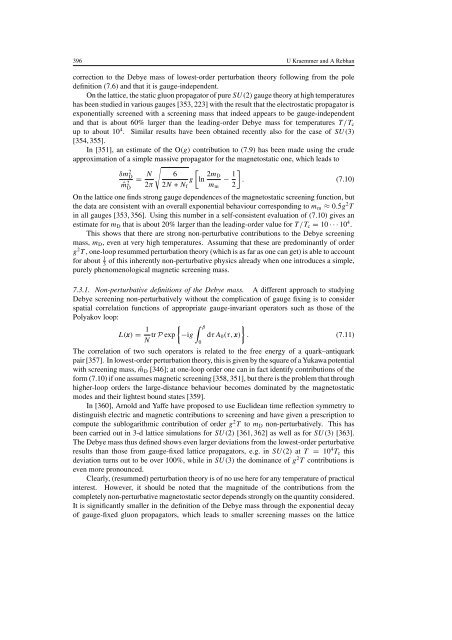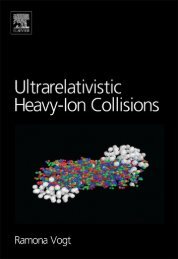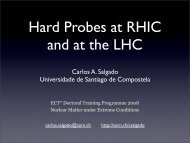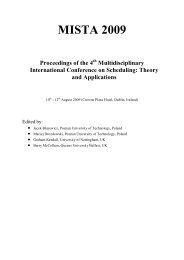Advances in perturbative thermal field theory - Ultra-relativistic ...
Advances in perturbative thermal field theory - Ultra-relativistic ...
Advances in perturbative thermal field theory - Ultra-relativistic ...
You also want an ePaper? Increase the reach of your titles
YUMPU automatically turns print PDFs into web optimized ePapers that Google loves.
396 U Kraemmer and A Rebhan<br />
correction to the Debye mass of lowest-order perturbation <strong>theory</strong> follow<strong>in</strong>g from the pole<br />
def<strong>in</strong>ition (7.6) and that it is gauge-<strong>in</strong>dependent.<br />
On the lattice, the static gluon propagator of pure SU(2) gauge <strong>theory</strong> at high temperatures<br />
has been studied <strong>in</strong> various gauges [353, 223] with the result that the electrostatic propagator is<br />
exponentially screened with a screen<strong>in</strong>g mass that <strong>in</strong>deed appears to be gauge-<strong>in</strong>dependent<br />
and that is about 60% larger than the lead<strong>in</strong>g-order Debye mass for temperatures T/T c<br />
up to about 10 4 . Similar results have been obta<strong>in</strong>ed recently also for the case of SU(3)<br />
[354, 355].<br />
In [351], an estimate of the O(g) contribution to (7.9) has been made us<strong>in</strong>g the crude<br />
approximation of a simple massive propagator for the magnetostatic one, which leads to<br />
√<br />
[<br />
ln 2m D<br />
m m<br />
− 1 2<br />
]<br />
. (7.10)<br />
δm 2 D<br />
ˆm 2 = N 6<br />
g<br />
D<br />
2π 2N + N f<br />
On the lattice one f<strong>in</strong>ds strong gauge dependences of the magnetostatic screen<strong>in</strong>g function, but<br />
the data are consistent with an overall exponential behaviour correspond<strong>in</strong>g to m m ≈ 0.5g 2 T<br />
<strong>in</strong> all gauges [353, 356]. Us<strong>in</strong>g this number <strong>in</strong> a self-consistent evaluation of (7.10) gives an<br />
estimate for m D that is about 20% larger than the lead<strong>in</strong>g-order value for T/T c = 10 ···10 4 .<br />
This shows that there are strong non-<strong>perturbative</strong> contributions to the Debye screen<strong>in</strong>g<br />
mass, m D , even at very high temperatures. Assum<strong>in</strong>g that these are predom<strong>in</strong>antly of order<br />
g 2 T , one-loop resummed perturbation <strong>theory</strong> (which is as far as one can get) is able to account<br />
for about 1 of this <strong>in</strong>herently non-<strong>perturbative</strong> physics already when one <strong>in</strong>troduces a simple,<br />
3<br />
purely phenomenological magnetic screen<strong>in</strong>g mass.<br />
7.3.1. Non-<strong>perturbative</strong> def<strong>in</strong>itions of the Debye mass. A different approach to study<strong>in</strong>g<br />
Debye screen<strong>in</strong>g non-<strong>perturbative</strong>ly without the complication of gauge fix<strong>in</strong>g is to consider<br />
spatial correlation functions of appropriate gauge-<strong>in</strong>variant operators such as those of the<br />
Polyakov loop:<br />
L(x) = 1 ∫ β<br />
}<br />
{−ig<br />
N tr P exp dτA 0 (τ, x) . (7.11)<br />
0<br />
The correlation of two such operators is related to the free energy of a quark–antiquark<br />
pair [357]. In lowest-order perturbation <strong>theory</strong>, this is given by the square of a Yukawa potential<br />
with screen<strong>in</strong>g mass, ˆm D [346]; at one-loop order one can <strong>in</strong> fact identify contributions of the<br />
form (7.10) if one assumes magnetic screen<strong>in</strong>g [358, 351], but there is the problem that through<br />
higher-loop orders the large-distance behaviour becomes dom<strong>in</strong>ated by the magnetostatic<br />
modes and their lightest bound states [359].<br />
In [360], Arnold and Yaffe have proposed to use Euclidean time reflection symmetry to<br />
dist<strong>in</strong>guish electric and magnetic contributions to screen<strong>in</strong>g and have given a prescription to<br />
compute the sublogarithmic contribution of order g 2 T to m D non-<strong>perturbative</strong>ly. This has<br />
been carried out <strong>in</strong> 3-d lattice simulations for SU(2) [361, 362] as well as for SU(3) [363].<br />
The Debye mass thus def<strong>in</strong>ed shows even larger deviations from the lowest-order <strong>perturbative</strong><br />
results than those from gauge-fixed lattice propagators, e.g. <strong>in</strong> SU(2) at T = 10 4 T c this<br />
deviation turns out to be over 100%, while <strong>in</strong> SU(3) the dom<strong>in</strong>ance of g 2 T contributions is<br />
even more pronounced.<br />
Clearly, (resummed) perturbation <strong>theory</strong> is of no use here for any temperature of practical<br />
<strong>in</strong>terest. However, it should be noted that the magnitude of the contributions from the<br />
completely non-<strong>perturbative</strong> magnetostatic sector depends strongly on the quantity considered.<br />
It is significantly smaller <strong>in</strong> the def<strong>in</strong>ition of the Debye mass through the exponential decay<br />
of gauge-fixed gluon propagators, which leads to smaller screen<strong>in</strong>g masses on the lattice







